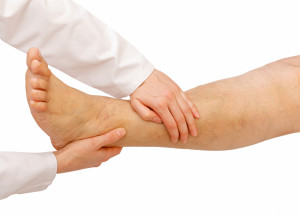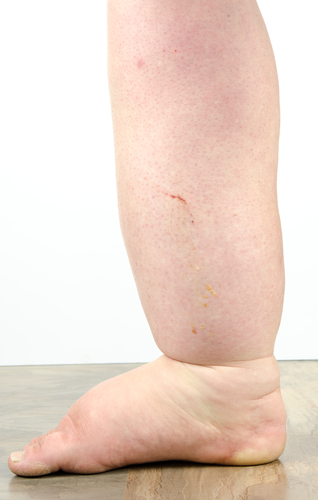 A common problem with Idiopathic Pulmonary Fibrosis is the slow development of leg swelling or edema. This process is a maladaptive response to progressive lung disease. The heart, lungs, kidneys and brain all talk to each other through hormones. In health, the heart pumps adequate amounts of blood to the kidneys. Fluid and salt in your body are meticulously regulated. If you eat a salty meal, you may retain fluid for a day or two but gradually your body will excrete the extra salt in your urine. If you don’t take in enough water, your brain will send out a hormone signal that will make you thirsty and prompt your kidneys to retain more water.
A common problem with Idiopathic Pulmonary Fibrosis is the slow development of leg swelling or edema. This process is a maladaptive response to progressive lung disease. The heart, lungs, kidneys and brain all talk to each other through hormones. In health, the heart pumps adequate amounts of blood to the kidneys. Fluid and salt in your body are meticulously regulated. If you eat a salty meal, you may retain fluid for a day or two but gradually your body will excrete the extra salt in your urine. If you don’t take in enough water, your brain will send out a hormone signal that will make you thirsty and prompt your kidneys to retain more water.
In IPF, as the disease progresses, the right side of the heart gradually has to work harder to pump blood through fewer blood vessels. This is like directing freeway traffic through fewer lanes. As the right side of the heart works extra hard, it gradually decreases the amount of blood that it pumps. As a means of compensating, the brain releases hormones that prompt the kidneys to retain salt and water. As this process progresses, you slowly retain more and more fluid.
The extra fluid percolates throughout your body and settles in the lowest or most dependent areas. If you were to hang upside down like a bat, the fluid would accumulate in your head. For most of us, our legs are the lowest part of our body. So gradually during the day, the fluid builds up in your legs and you notice this as leg swelling. If you push firmly over your shins when you have leg swelling, you will notice a depression. This depression is referred to as “pitting”.
At night when you go to sleep, the extra fluid will gradually return to your blood vessels and other areas of your body that are dependent. Generally, leg swelling is much improved in the early morning when you first wakeup. Many patients notice that they have to urinate more frequently during the night. This is due to the kidneys excreting some of the extra fluid that has returned to the circulation during the course of the night.
Abdominal Swelling in Pulmonary Fibrosis Patients
Some patients will also collect fluid in their abdomen. This leads to a sensation of abdominal fullness. Patients may notice decreased appetite or feeling full prematurely during a meal. You can have abdominal swelling (also called ascites) with or without swelling in your legs. In the early stages, few patients recognize that they are having abdominal swelling. Usually patients are losing lean body mass and slowly retaining fluid.
The technical term for the development of leg and or abdominal swelling accompanying lung disease is cor pulmonale. This means right heart failure due to lung disease. It can be seen in any form of advanced lung disease but most commonly occurs in IPF. and emphysema. It signifies advanced lung disease and should prompt you and your doctor to re-evaluate your current situation.
Treating Leg and Abdominal Swelling (Edema and Ascites)

Diet Issues Related to Swelling
My approach to fluid retention in IPF is to start by reviewing the patient’s diet. The problem may be as simple as excessive salt intake. For example, if you eat fast food or eat in a restaurant frequently, you may consume 4,000mg of Salt (sodium chloride) in a day. This is twice the upper limit of reasonable salt consumption for lung disease. Other patients drink excessive amounts of fluid. A reasonable goal is no more than 2,000mg of salt and no more than 64 ounces of fluids.
Medication Issues Related to Swelling
Next I review the medication list looking for mediations that promote salt and fluid retention or are associated with leg swelling. The most common culprits are Gabapentin and Lyrica. Narcotic pain medications can also promote fluid retention. Amlodipine (Norvasc) and Nifedipine (Adalat) are blood pressure medicines that cause lower extremity swelling that looks identical to the edema or heart failure but is due to leakiness in the leg blood vessels. Removing the offending agents is a first step.
Using Oxygen to Reduce Fluid Retention
Next I review if the patient needs or is using oxygen. If a patient requires oxygen but does not use oxygen, this strongly promotes fluid retention. Simply using your oxygen (or your CPAP if you have sleep apnea) can dramatically improve fluid retention.
Are there Reversible Features of the Lung Disease?
Repeat chest imaging and spirometry help reassess the status of a patient’s lung disease. The possibility of blood clots in the legs and lungs should at least be considered if the onset was sudden and associated with increased shortness of breath. An exacerbation or flare of IPF may also result in fluid retention. Appropriate treatment to address any reversible lung process should be undertaken.
Diuretics Used to Reduce Swelling & Fluid Retention
The next step is adding or increasing diuretics (medicines that increase urine production). Furosemide (Lasix) is usually the first diuretic I add. Often I will add a second diuretic called Spironolactone (Aldactone) to minimize the amount of potassium that is lost in the urine. After I start diuretics, I always check blood work a week or so later to ensure that the kidneys and electrolytes are in balance. Compression stockings can also be helpful in treating lower extremity swelling.
Has Pulmonary Hypertension Developed?
Lastly, I consider the possibility that pulmonary hypertension has developed. An echocardiogram and perhaps a right heart catheterization can answer this question. If pulmonary hypertension has developed, I may start specific medications to address that problem. (See page on treatment of Pulmonary Hypertension in IPF patients).